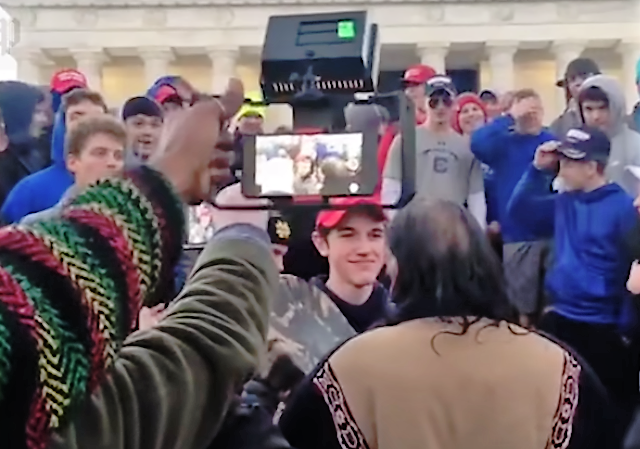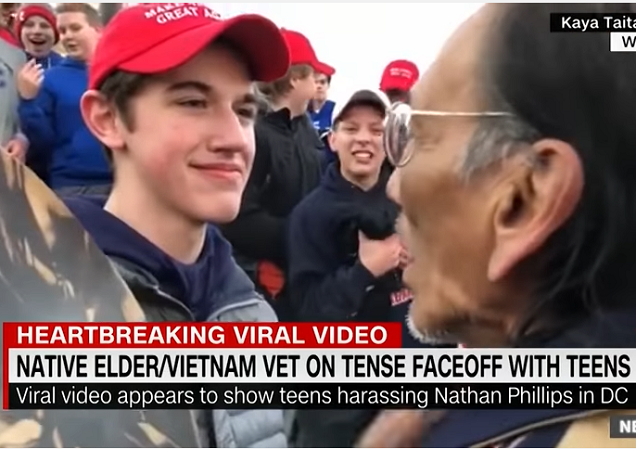Nick Sandmann Loses Appeal Over Dismissal of Defamation Claims Against Several Media Outlets

You will recall Nick Sandmann, the Covington (KY) Catholic High School kid who became the object of media fury in January 2019 when visiting D.C. on a school trip for the March for Life.
Sandmann was minding his own business when an activist got in his face banging a drum inches from his face.
Because Sandmann stood there stoicly with a slight smirk on his face, various media types went in a full-blown rage at him, falsely accusing him of initiating the confrontation, blocking and harassing the activist. Because he was wearing a MAGA hat, the full insane fury of the #Resistance was visited upon him.
We covered the story over dozens of posts. As more video and facts emerged, a very different narrative was revealed. The activist was the provocateur:
- Media Narrative of “Catholic MAGA high schoolers mob Native American elder” doesn’t hold up to video scrutiny
- Kentucky Student Speaks Out: ‘I Will Not Stand for This Mob-Like Character Assassination of my Family’s Name’
- WAPO Corrects Covington Smear Story to Say Native American Activist Didn’t Fight in the Vietnam War
- Investigation Clears Covington Catholic Students, “No Evidence of Offensive or Racist Statements”
Sandmann hired counsel, and sued The Washington Post, (which issued a correction and settled), CNN (which settled), NBC (which settled) and NY Times, ABC, CBS, and Rolling Stone, and others.
The lawsuits were dismissed because the District Court found the alleged defamatory statements were protected opinion.
A panel of the 6th Circuit Court of Appeals affirmed the dismissal today in a split (2-1) decision. From the majority opinion:
On January 18, 2019, then-sixteen-year-old Nicholas Sandmann and his classmates had an interaction with a Native American man named Nathan Phillips by the Lincoln Memorial in Washington, D.C. Video of the incident went viral, and national news organizations, including the five Defendants (Appellees, or News Organizations) published stories about the day’s events and the ensuing public reaction. Sandmann sued, alleging that the Appellees’ reporting, which included statements from Phillips about the encounter, was defamatory. The district court granted the News Organizations’ joint motion for summary judgment, finding that the challenged statements were opinion, not fact, and therefore nonactionable. Sandmann appealed. For the following reasons, we AFFIRM.
The Court went through each of the statements sued-upon, and found that they were opinion, particularly the key media assertion that Sandmann “blocked” the activist (which the video shows was not true).
The dissent was as long as the majority opinion, arguing that the issue should have gone to a jury:
These cases raise classic claims of defamation. Through their news reporting, defendants portrayed plaintiff Nicholas Sandmann as a racist against Native Americans. Their characterization of Nicholas was vicious, widespread, and false. Defendants’ common narrative was readily accepted and effective to the extent that, on national television, NBC’s1 Today Show host Savannah Guthrie asked the 16-year-old if he thought he “owe[d] anybody an apology” for his actions and if he saw his “own fault in any way.”2 Moreover, the false portrayal of Nicholas caused the Diocese of Covington to issue an apology for its parishioner’s actions. An apology that was later retracted once the Diocese learned the truth. The truth is depicted on eighteen stipulated videos of the incident, which unequivocally show that 16-year-old Nicholas Sandmann did nothing more than stand still and smile while confronted by a stranger.3 These cases should be submitted to a jury to decide the factual issue of whether each defendant exercised reasonable care in its reporting. I disagree that summary judgment is appropriate. In this regard, the majority opinion affirms the summary judgment granted in favor of all defendants, not on the basis that their reporting was substantially true or that plaintiff was a public figure necessitating a claim of malice, but on the ground that all the news articles were opinion, not fact. I disagree and would reverse and remand for further proceedings.In my view, the statements that Sandmann blocked Nathan Phillips’s ascension to the Lincoln Memorial; prevented Phillips from retreating; and impeded Phillips’s movements by stepping to his left and stepping to his right, were actions capable of objective verification. Thus, because these events can be objectively verified, I would hold that the opinion exception to the laws of defamation does not apply.
What next?
Law professor Jonathan Adler thinks this case might be ripe for ‘en banc’ review by the entire 6th Circuit, given the long dissent. After that, it’s probably the end of the road, I can’t see this as a case the Supreme Court would take.
CLICK HERE FOR FULL VERSION OF THIS STORY

